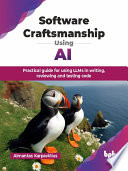Product desciption
Software Craftsmanship Using Ai Practical Guide For Using Llms In Writing Reviewing And Testing Code Almantas Karpaviius by Almantas Karpavičius 9789365892420, 9365892422 instant download after payment.
DESCRIPTION This book is a workshop to create software using AI. A reader will be taken through a series of requirements and create a practical API from scratch. AI is without a doubt a productivity boost, and our goal is to help you maximize the boost by writing prompts effectively to generate, refactor, test, and review code. This book is also a modern take on software design fundamentals. To be able to scrutinize AI-generated code and to be able to guide AI effectively to better results, one should understand the theory behind software design. It starts with basics like clean function design and object-oriented principles, then advances to SOLID principles, design patterns, and Onion architecture. Readers will learn essential testing methods, including unit, integration, and acceptance tests using BDD and Specflow. The guide covers API development, focusing on security, validation, error handling, and external system integration. It also explains CI/CD pipelines using Azure DevOps, including build and deployment pipelines with YAML configurations. Lastly, this book teaches us to embrace the changes in software requirements. The end goal is to teach a reader how to implement changes in software with minimum change to existing lines of code.You will be well-equipped to leverage AI as a valuable asset in your software development toolbox. KEY FEATURES ● Using AI tools to enhance your development process, from code generation to testing. ● Build a real-world "Nutrition Advisor" application from start to finish, applying the concepts and techniques learned throughout the book. ● Discover how to write clean, maintainable code using SOLID principles. WHAT YOU WILL LEARN ● The fundamentals of software design like KISS, OOP, SOLID, and key design Patterns. ● Use Effective prompt engineering for generating code, refactoring, testing, and reviewing. ● Code review both for human and AI-generated code. ● Design which minimizes changes when new requirements are introduced. ● Build .NET REST Web API with tests. ● Build CI/CD pipelines to deploy to Azure. WHO THIS BOOK IS FOR This book is intended for software developers, aspiring programmers, and students in computer science or related fields who have a basic understanding of programming concepts and are eager to deepen their knowledge of software design principles and best practices. TABLE OF CONTENTS 1. Clean Functions 2. Object Oriented Programming 3. SOLID Principles 4. Design Patterns 5. Unit Testing 6. Building a Web API 7. ChatGPT Integration to WebAPI 8. Clean Architecture 9. Continuous Integration 10. Continuous Deployment Appendix A: Final Thoughts Appendix B: Cheat Sheet


